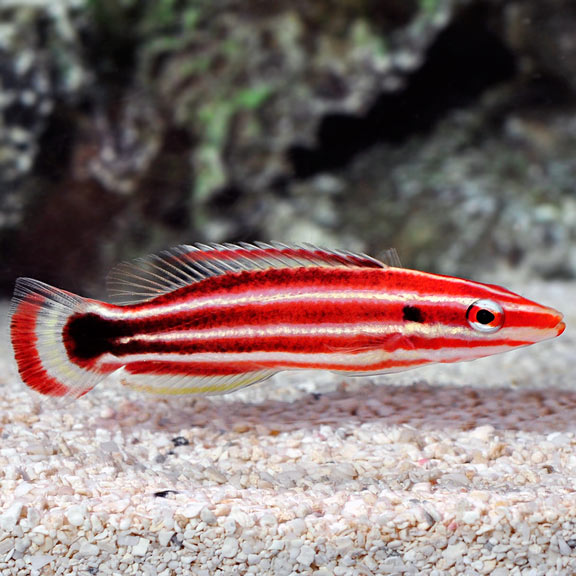The Candy Cane Hog, scientifically known as Bodianus sepiacaudus, is a small to medium-sized fish with a maximum size of around 8 inches (20 cm). It has a robust and elongated body with vibrant colouration. The body is predominantly reddish-orange, adorned with vertical white stripes resembling candy canes. The fins are also brightly coloured, with the dorsal fin featuring a contrasting black hues.
Taxonomy:
The Candy Cane Hog belongs to the family Labridae and the genus Bodianus. Its scientific name is Bodianus sepiacaudus.
Natural Habitat:
The Candy Cane Hog is typically found in coral reef environments. It inhabits areas with clear waters and moderate to strong water movement. These fish prefer to stay close to the reef structure, where they can find shelter and explore crevices and caves.
Keeping the Candy Cane Hog Healthy:
The Candy Cane Hog requires a moderate level of care and is suitable for intermediate-level marine aquarium keepers. While they are generally hardy, they can be sensitive to changes in water quality and parameters. Providing a stable and well-maintained environment is essential for their health and well-being.
Special Requirements and Feeding:
The Candy Cane Hog is an omnivorous species, primarily feeding on small invertebrates, crustaceans, and various types of meaty foods. A varied diet consisting of high-quality marine pellets, frozen or live foods, and occasional vegetable matter will help meet their nutritional needs. It is recommended to feed them multiple times a day in smaller portions to mimic their natural feeding behaviour.
How Many Should I Keep:
Candy Cane Hogs are generally territorial and solitary fish. It is best to keep them singly or in mated pairs to reduce aggression and territorial disputes. Providing adequate hiding places and territories within the aquarium will help alleviate aggression.
Lighting Preference:
The Candy Cane Hog does not have specific lighting requirements. However, it is important to provide a well-lit aquarium that mimics natural daylight conditions.
Suitable Tank Mates:
When selecting tank mates for the Candy Cane Hog, it is essential to consider their semi-aggressive nature and territorial behaviour. They may display aggression towards smaller or less assertive fish. Suitable tank mates include other moderately aggressive species that can hold their own, such as other wrasses, dottybacks, or larger damselfish. Care should be taken to avoid housing them with small, slow-moving, or peaceful fish that may become targets of aggression.
Reproduction in the Wild:
Candy Cane Hogs, or Bodianus sepiacaudus, reproduce through a process known as broadcast spawning. During spawning, the male and female fish release their gametes into the water simultaneously. This synchronized release increases the chances of successful fertilization. The eggs are buoyant and drift in the water column until they hatch into larvae.
Breeding Bodianus sepiacaudus:
- Set up:
To breed Candy Cane Hogs in captivity, a spacious and well-maintained aquarium with appropriate water conditions is required. Provide ample hiding places and crevices for the fish to establish territories and courtship behaviour.
- Courtship/Spawning:
Breeding usually begins with courtship displays by the male, which involve fin flaring and colouration changes. The male will entice the female to a suitable spawning site and perform courtship dances to encourage her to release eggs. The simultaneous release of gametes occurs, and the eggs are fertilized in the water column.
- Rearing:
After spawning, it is crucial to promptly remove the eggs from the main aquarium to a separate rearing tank. The eggs are delicate and require specific water conditions and specialized equipment to ensure their survival. The eggs will hatch into larvae, which have different nutritional needs compared to adult fish. Providing appropriate food sources, such as rotifers and other small live foods, is essential for their growth and development.
Sexual Dimorphism:
Sexual dimorphism in Candy Cane Hogs is not prominently displayed. Male and female individuals often have similar physical characteristics and colouration.
Distribution:
The Candy Cane Hog (Bodianus sepiacaudus) is found in the Indo-Pacific region, including the Maldives, Sri Lanka, and the Andaman Sea. While captive-bred or line-bred strains of this fish may be available in the aquarium trade, the original wild fish are sourced from their natural habitats in the Indo-Pacific region.
Summary:
The Candy Cane Hog (Bodianus sepiacaudus) is a visually captivating fish with reddish-orange body and white candy cane-like stripes. It requires a moderate level of care and is suitable for intermediate-level marine aquarium keepers. The fish reproduce through broadcast spawning in the wild, with synchronized release of gametes leading to fertilization. Breeding in captivity requires proper tank setup, courtship displays, and separate rearing of eggs. This fish is widely distributed in the Indo-Pacific region, and while captive-bred strains may be available, the original fish are sourced from their natural habitats.





Reviews
There are no reviews yet.